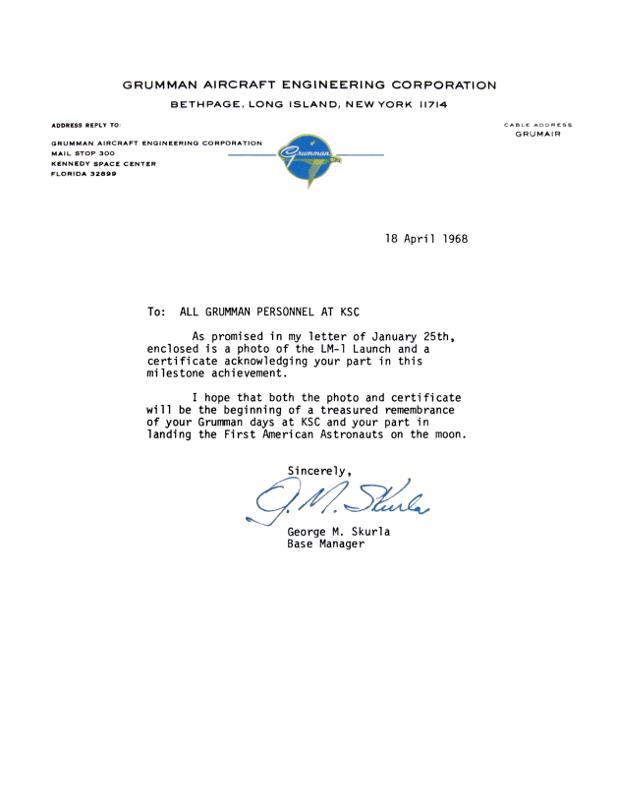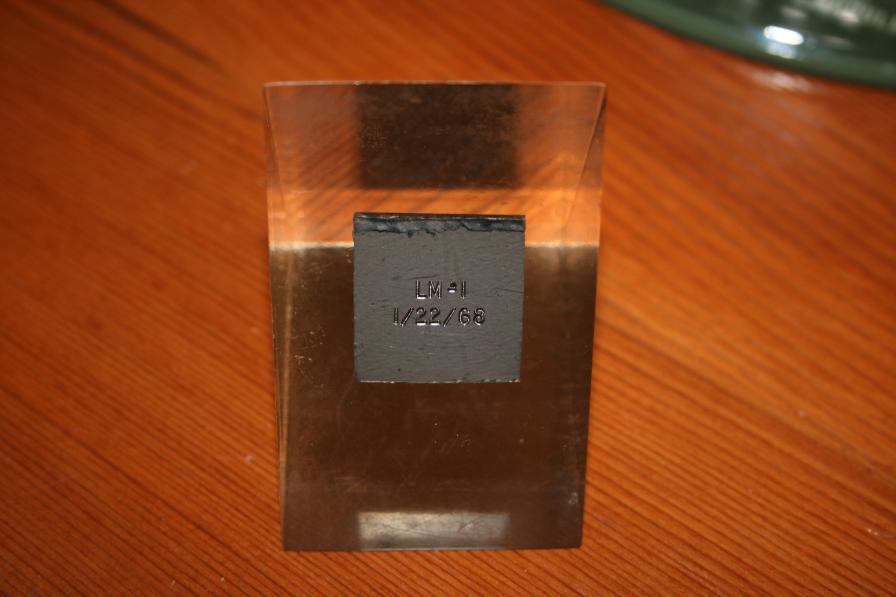LM-1 Certificate of Participation
I recently acquired a certification of participation for the LM-1 launch:
Click image for a 2100x1650 pixel version of this image in a new window.
Click here for a 8400x6600
pixel version of this image in a new window.
Scan by heroicrelics.
Originally issued to Sheldon W. Brown Jr., the text of the certificate reads
Grumman
Lunar Module Pioneer
This is to acknowledge that
Sheldon W. Brown Jr.
was a member of the
Grumman Aircraft Engineering Corporation "team"
at the
Kennedy Space Center, Florida
when the first
Apollo Lunar Landing Spacecraft
was launched on January 22, 1968
L. J. Evans
PresidentJ.G. Gavin, Jr., Vice President
LM Program DirectorGeorge F. Titterton
Senior Vice PresidentG. M. Skurla
KSC Base Manager
The certificate of participation was accompanied by a presentation letter:
From an eBay auction listing.
Click image for a 1258x1628 pixel version of this image in a new window.
Restoration by heroicrelics.
The presentation letter reads
18 April 1968
To: ALL GRUMMAN PERSONNEL AT KSC
As promised in my letter of January 25th, enclosed is a photo of the LM-1 launch and a certificate acknowledging your part in this milestone achievement.
I hope that the photo and the certificate will be the beginning of a treasured remembrance of your Grumman days at KSC and your part in landing the First American Astronauts on the moon.
Sincerely,
George M. Skurla
Base Manager
I'm uncertain as to which LM-1/Apollo 5 launch photo was included with the certificate of participation.
LM-1 History and Mission
LM-1 was the first production lunar module, and the first, unmanned, lunar module to fly in space (during the Apollo 5 mission, on the AS-204 Saturn IB). As it was unmanned, there was no need to return a crew in a command module, so the mission flew an unusually-configured Saturn IB.
The plan was to fire the descent (DPS) engine twice; during the second firing, the ascent stage's (APS) engine would execute a "fire in the hole" burn, simulating an abort that the astronauts might need to perform during a lunar landing attempt (more information is available in the Apollo 5 press kit).
Unfortunately, things didn't work out quite as planned: The first firing of the DPS engine was aborted by the computer after only 4 seconds. The computer was programmed to expect a certain amount of thrust after a certain period of time, and when the engine did not provide the required thrust, the computer assumed that the engine was malfunctioning and shut it down. NASA eventually concluded that this lack of thrust buildup was due to inadequate propellant tank pressurization (LM-1 was running software which assumed the DPS had an ambient helium tank, in addition to the supercritical helium tank, to pressurize propellant tanks, but LM-1 lacked this ambient helium bottle as it was a hardware modification added to subsequent vehicles), although at least one engineer who worked on LM-1 has an alternate theory. Additional information on the DPS anomaly can be found in the Apollo 5 Final Flight Evaluation Report and the Final Analysis of the Descent Propulsion System During the Flight of Apollo 5.
Ground controllers were able to execute an alternate mission plan and were able to perform both a "fire in the hole" APS engine burn and a second planned burn. The second APS engine burn left the ascent stage of the lunar module in an orbit which quickly resulted in its reentry over the Pacific Ocean, and the remains of the ascent stage impacted the ocean southwest of Baja California. Additional information, including a more detailed analysis of the ascent stage's reentry, can be found in the Apollo 5 Mission Report, as well as in Pellegrino and Stoff's Chariots for Apollo.
However, the descent stage remained in orbit for several more weeks, not reentering until February 12, 1968. Its remains showered over South America. Part of the descent stage was quickly discovered in Colombia, but a .9m spherical tank escaped detection until June 1970.
The tank was returned to the US, where part of it was returned to Grumman. Chariots for Apollo includes a story about how 1" squares were cut out of it, stamped with "LM-1", and given to employees as souvenirs. By the looks of the tank section, there must have been a relatively small number of squares cut from the tank section. Another part of the tank was taken to NORAD's Cheyenne Mountain facility, where it was similarly mounted. I have received recent confirmation that it still hangs as a display piece to this day (although I've never seen a picture of that tank fragment).
Although I'd done a good deal of Internet searches and made postings on space history message boards, at that point I had never seen a picture of one of these souvenirs or read any other accounts of it (the Grumman History Center hadn't heard such an account, either).
In 2009, a collector posted a photo of a recently-acquired presentation containing a portion of the descent propellant tank from LM-1 to a space message board. Although not one of the LM-1 squares, it was the first LM-1 presentation I'd seen:
Photo courtesy of Phil White.
It turns out that one of these LM-1 squares was awarded to Morton "Bob" Mantus. Bob Mantus was a Grumman engineer who worked on the lunar module's landing gear, and authored a number of technical papers, including some early papers on landing dynamics. (Most of his LM-related papers appeared in copyrighted technical journals, but one non-copyrighted paper ["Lunar Module Alightment System", regarding the LM's landing phase] appears on page 67 (p. 68 in the PDF) of the Proceedings of the 2nd Aerospace Mechanisms Symposium).
Bob's son found my LM-1 page on the Internet in October 2010 and forwarded a picture of his father's LM-1 square:
Click image for a 3888x2592 pixel version of this image in a new window.
Photo by D. Mantus.
Based on the tank's description (spherical .9m titanium tank), I have concluded that this is the LM's supercritical helium (SHe) tank. Both the Grumman History Center and Scott Sullivan, author of Virtual LM, have told me that the SHe tank was the only spherical tank in the descent stage of that approximate diameter. Additional information about the LM SHe tank can be found in A Cryogenic Helium Pressurization System for the Lunar Excursion Module. Some background information, as well as a diagram of the tank, is available in Pressure Rise Rates of the LM-10 Supercritical Helium SHe Tank.



